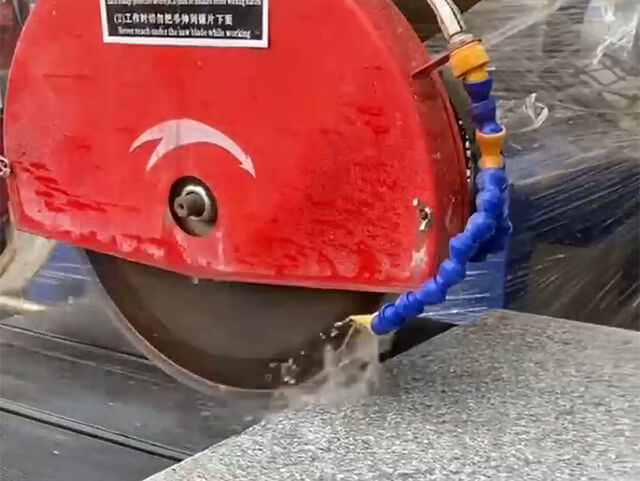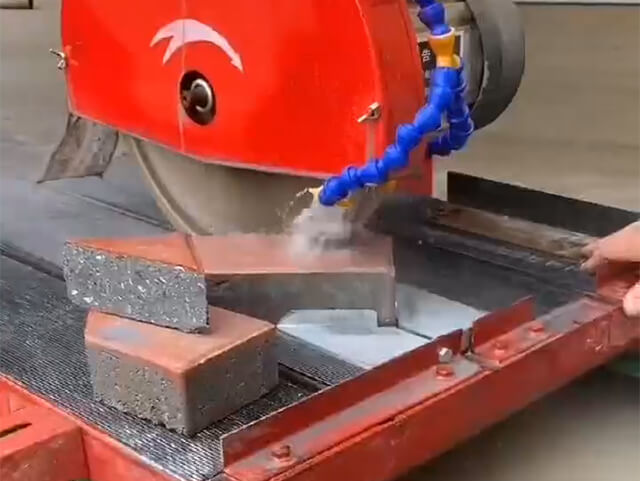Author:Dafon Kerbstone Machine FROM:Stone Machine Manufacturer TIME:2024-08-20
The best way to cut paver stones depends on the material of the pavers and the precision required. Here's a step-by-step guide to achieve clean, accurate cuts:
1. Choose the Right Tool
Masonry Saw (Wet Saw or Bridge Saw): Ideal for precise cuts on stone, concrete, or brick pavers. It uses water to cool the blade and reduce dust.
Angle Grinder with a Diamond Blade: Good for quick, rough cuts and more portable than a masonry saw.
Block Splitter (Paver Splitter): Best for making straight, clean cuts on concrete or brick pavers without dust.
Circular Saw with a Diamond Blade: Suitable for a variety of materials, offering mobility and versatility.
Chisel and Hammer: Ideal for small adjustments or rustic finishes.
2. Measure and Mark the Cut Line
Measure Twice, Cut Once: Use a measuring tape to mark where the cut will be.
Mark the Cut Line: Use a pencil or chalk to draw the line on the paver, ensuring it's visible.
3. Prepare the Work Area
Safety Gear: Wear safety glasses, gloves, hearing protection, and a dust mask.
Work Surface: Place the paver on a stable surface like a workbench. If using a power tool, ensure the paver is secured with clamps to prevent movement.
4. Cutting the Paver
Using a Masonry Saw:
Set Up the Saw: Adjust the blade depth according to the paver thickness.
Start the Cut: Turn on the saw, slowly guide the paver into the blade along the marked line. Keep a steady pace to avoid chipping.
Complete the Cut: Finish the cut in a single pass if possible. For thicker pavers, you might need to flip the paver and cut from the other side.
Using an Angle Grinder:
Score the Line: First, lightly score along the marked line with the grinder to create a guide.
Cut Deeper: Gradually cut deeper along the scored line until the paver is fully cut through.
Using a Block Splitter:
Align the Paver: Place the paver in the splitter, aligning the marked line with the blade.
Apply Pressure: Pull the lever to split the paver cleanly along the line.
Using a Chisel and Hammer:
Score the Line: Score along the marked line with the chisel.
Split the Paver: Place the chisel in the scored line, tap with the hammer to split the paver.
5. Finishing Touches
Smooth the Edges: If needed, use a file or angle grinder to smooth out any rough edges.
Clean Up: Wipe down the paver to remove any dust or debris.
6. Safety Considerations
Water Use: If using a wet saw, ensure a continuous water flow to keep the blade cool and minimize dust.
Ventilation: Work in a well-ventilated area to avoid inhaling dust.
For the cleanest and most precise results, a masonry saw or bridge saw is generally considered the best option, especially for large projects or when working with natural stone pavers.

When cutting pavers, the choice of tools depends on the material of the pavers, the precision required, and the scale of the project. Here are some of the best tools commonly used:
Masonry Saw (Wet Saw or Bridge Saw):
Best for: Precision cutting of pavers made from materials like concrete, stone, or brick.
Advantages: Uses a diamond blade and water to cool the blade, reducing dust and providing smooth, accurate cuts.
Ideal Use: Large-scale projects or when high precision is needed.
Angle Grinder:
Best for: Quick, rough cuts on concrete, brick, or stone pavers.
Advantages: Portable and versatile, can be used for straight or curved cuts with different types of diamond blades.
Ideal Use: Small to medium-scale projects or for making custom cuts.
Block Splitter (Paver Splitter):
Best for: Cutting concrete or brick pavers.
Advantages: Manually operated, doesn’t require electricity, quick and clean splits without creating dust.
Ideal Use: Smaller projects or when you need to make straight cuts on a large number of pavers.
Circular Saw with a Diamond Blade:
Best for: Cutting concrete, stone, or brick pavers.
Advantages: More portable than a masonry saw and can handle a variety of materials with the right blade.
Ideal Use: Medium-scale projects or when mobility is a concern.
Chisel and Hammer:
Best for: Small adjustments or rough cutting of pavers.
Advantages: Simple, cost-effective, and doesn't require power tools.
Ideal Use: Finishing touches or when only a few pavers need to be cut.
For a professional finish on large projects, using a masonry saw or a bridge saw is recommended, especially if you're working with harder materials like natural stone.

Yes, You Can Cut Pavers Without a Wet Saw
While a wet saw is the preferred method for precise and efficient paver cutting, it's not strictly necessary. Here are some alternative methods:
Alternative Methods for Cutting Pavers:
Angle Grinder with Diamond Blade: This is a popular choice for DIYers. It's versatile but can be noisy and generate dust.
Hammer and Chisel: A more traditional method, best suited for small cuts or rough shaping. It's labor-intensive and can result in uneven edges.
Paver Splitter: Designed specifically for splitting pavers, this tool can provide cleaner breaks than a hammer and chisel.
Circular Saw with Diamond Blade: Similar to an angle grinder but with a larger blade, this can be used for straight cuts.
Important Note: Always wear safety gear, including goggles, gloves, and a dust mask, when cutting pavers.
